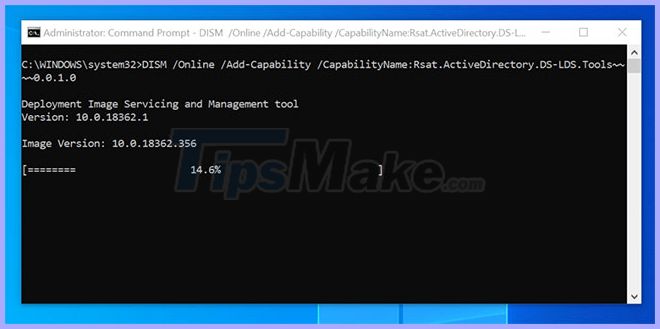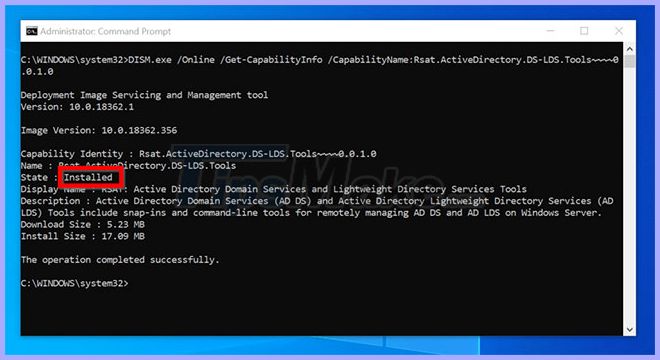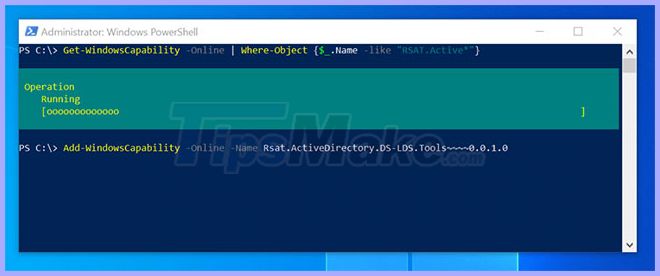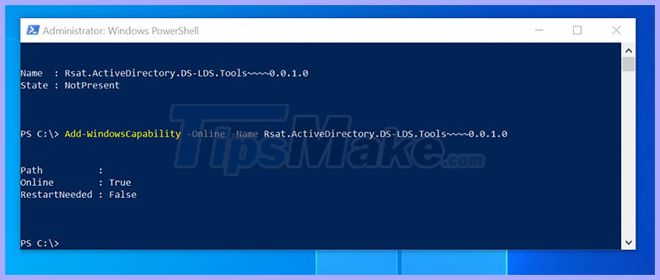How to enable RSAT for Active Directory in Windows 10
1. Install RSAT for Active Directory in Windows 10 with Manage Optional Features
To enable Active Directory with this method:
Enter Optional Features in the search bar. Then select Manage Optional Features.
Then click Add features.
Move to RSAT: Active Directory Domain Services and Lighweight Directory Services Tools . Then click on it.
 Click RSAT: Active Directory Domain Services and Lighweight Directory Services Tools
Click RSAT: Active Directory Domain Services and Lighweight Directory Services Tools Click on Install.
 Click on Install
Click on Install To confirm that the feature has been installed, click the back button next to Settings.
Then click See optional feature history . The feature installation progress bar is displayed.
 The feature installation progress bar is displayed
The feature installation progress bar is displayed When the installation is complete, scroll down to the Optional features list . RSAT: Active Directory Domain Services and Lighweight Directory Services Tools will be listed.
To confirm that this feature is installed, search for Active Directory. You will find all AD tools.
2. Install RSAT for Active Directory in Windows 10 with DISM
Another method to install Active Directory is to use the DISM Command.
Here are the steps to take:
Open Command Prompt with admin rights.
Then, at the User Account Control prompt , click Yes.
Finally, in the Command Prompt , type this command, then press Enter.
DISM.exe /Online /Get-Capabilities | find "Rsat.Active"The command will display the RSAT feature name for Active Directory.
To install the Active Directory RSAT tools, type this command, then press Enter.
DISM /Online /Add-Capability /CapabilityName:Rsat.ActiveDirectory.DS-LDS.Tools~~~~0.0.1.0Copy the feature name from the / Get-Capabilities command . When you press Enter, the feature installation will begin
If the installation seems to be suspended, please wait patiently. It will eventually reach 100%.
 Installation is in progress
Installation is in progress Once the installation process is complete, you can confirm the installation using the command below:
DISM.exe /Online /Get-CapabilityInfo /CapabilityName:Rsat.ActiveDirectory.DS-LDS.Tools~~~~0.0.1.0This is the result of the command. State (state) is displayed as Installed .
 The state is displayed as Installed
The state is displayed as Installed 3. Install RSAT for Active Directory in Windows 10 with PowerShell
You can also enable RSAT for Active Directory in Windows 10 using PowerShell.
Here are the steps to take:
Open PowerShell as admin.
At the Powershell command prompt , type the command below, then press Enter.
Get-WindowsCapability -Online | Where-Object {$_.Name -like "RSAT.Active*"}The command will display the RSAT feature name for Active Directory.
To install the feature with PowerShell, enter this command and then press Enter. Copy the name of the feature from the result of the previous command.
Add-WindowsCapability -Online -Name Rsat.ActiveDirectory.DS-LDS.Tools~~~~0.0.1.0PowerShell will begin installing the feature, which may take a while to complete.
 PowerShell will begin installing the feature
PowerShell will begin installing the feature When the installation is completed, a result similar to the one below will be returned. If you need to restart the computer, RestartNeeded will display True.
 If you need to restart the computer, RestartNeeded will display True
If you need to restart the computer, RestartNeeded will display True Finally, to confirm the installation is successful, type this command, then press Enter.
Get-WindowsCapability -Online | Where-Object {$_.Name -like "RSAT.Active*"}State displays the Installed status .
You should read it
- Theory - What is Active Directory?
- How to install Active Directory on Windows Server 2019
- Restore deleted components in Active Directory
- Instructions for installing Active Directory on Windows Server 2008
- Prevent deleting data in Windows Server 2003 Active Directory
- Prepare Active Directory for Exchange 2007 (P.4)
 How to dual boot Chrome OS and Windows 10
How to dual boot Chrome OS and Windows 10 How to remove CRC SHA option from context menu in Windows 10
How to remove CRC SHA option from context menu in Windows 10 How to remove the 'Give access to' context menu on Windows 10
How to remove the 'Give access to' context menu on Windows 10 9 ways to open Recycle Bin on Windows 10
9 ways to open Recycle Bin on Windows 10 Create custom themes on Windows 10 with Stardock Curtains
Create custom themes on Windows 10 with Stardock Curtains